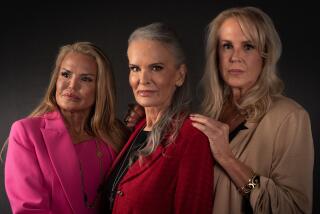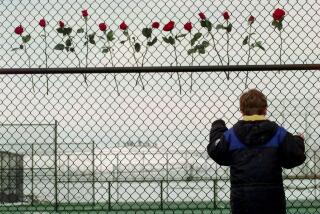Columbine, O Magazine and suicide
- Share via
The November issue of O Magazine (that’s the Oprah Magazine) features a series of articles about how to be “your true self,” a guide to do-it-yourself hair coloring and -- thud -- an essay by Susan Klebold. In April 1999, her son, Dylan, along with his classmate, Eric Harris, killed 12 students, a teacher and themselves in a massacre that would thereafter be known simply as Columbine, the deadliest high school shooting in the nation’s history.
Even for the indomitable Oprah Winfrey, Klebold must have been a real “get.” Klebold had apparently turned down repeated interview requests over the years, and a spokesperson announced that she has no plans to appear on “The Oprah Winfrey Show,” nor was she paid for the article.
“I’d had no inkling of the battle Dylan was waging in his mind,” Klebold wrote, admitting that even though a teacher had become alarmed by Dylan’s paper about a man in a black trench coat who murders nine students, friends and family remained convinced for months after the attack that he hadn’t meant to hurt anyone. Meanwhile, Susan Klebold was “nearly insane with sorrow for the suffering my son had caused, and with grief for the child I’d lost. Much of the time I felt that I could not breathe, and I often wished that I would die.”
What’s notable about the essay, aside from the way the details remain jaw-dropping even 10 years later, is Klebold’s decision to couch it as a form of suicide awareness. The last several paragraphs are largely devoted to various statistics about suicide, and Klebold even provides the phone number for the national suicide prevention “lifeline.” “I hope that, by reading of my experience, someone will see what I missed,” she writes.
We heard a lot about Columbine last April, the 10-year anniversary of the event. In his exhaustively researched book on the event, author Dave Cullen examined how the facts of what happened were so misrepresented and so misconstrued by the public that a set of myths arose that came to define the entire notion of disaffected adolescence, even if they had little to do with the event itself. Contrary to what was widely reported, the shooters were not members of a “trench coat mafia” who targeted jocks and other popular kids in their rampage. Instead, it seems fairly clear that Harris met the clinical definition of a psychopath, and Klebold’s suicidal depression made him vulnerable to Harris’ influence. Though they weren’t members of the “in crowd,” they had plenty of friends and weren’t widely seen as outcasts. Despite countless rumors otherwise, their victims were random.
But there was a reason the rumors gained such traction. It’s easier to believe in the idea of a trench coat mafia and to make pat assumptions about teenagers and their social hierarchy than it is to come to terms with the idea that one kid would kill for the sake of killing and another would so willingly go along for the ride.
And it’s hard not to see Susan Klebold’s essay as, if not a continuation of the myths, an extension of the impulse that causes people to repeat them. Though she comes across as a sincere and thoughtful woman, the net effect of the whole endeavor seems like a form of pandering -- to readers’ sympathies and, more important, to the American obsession with “closure.” We are not, after all, a culture that is particularly adept at accepting the more irrational aspects of tragedy, the randomness of death, the unknowability of a criminal’s motives. Instead, we like to make sense of it all, to learn from mistakes, to erect memorials, observe anniversaries and offer up platitudes about finding peace.
Though Klebold avoids words such as “closure” in her essay (and, indeed, it is clear she will never find peace), her choice to view her son chiefly through the lens of suicide -- and, to boot, to do it in O Magazine -- diminishes the enormity of what really happened. The ostensible reason for her article appearing now is that Nov. 21 is National Survivors of Suicide Day. But imagine being the mother of a suicide victim who didn’t happen to take 13 people along with him. Would you want to commemorate Nov. 21 with Susan Klebold? Or would you prefer she speak solely for herself, even if what she had to say offered no comfort because it fit no familiar idiom and offered no resolution?
My guess is the latter. Besides, as Dylan himself demonstrated in a video he and Harris made just before they started shooting, attempts at closure can be appallingly hollow. “I just wanted to apologize to you guys for any crap this might instigate,” he said to his parents.
Closure? Not even close.
--
More to Read
Sign up for our Book Club newsletter
Get the latest news, events and more from the Los Angeles Times Book Club, and help us get L.A. reading and talking.
You may occasionally receive promotional content from the Los Angeles Times.











